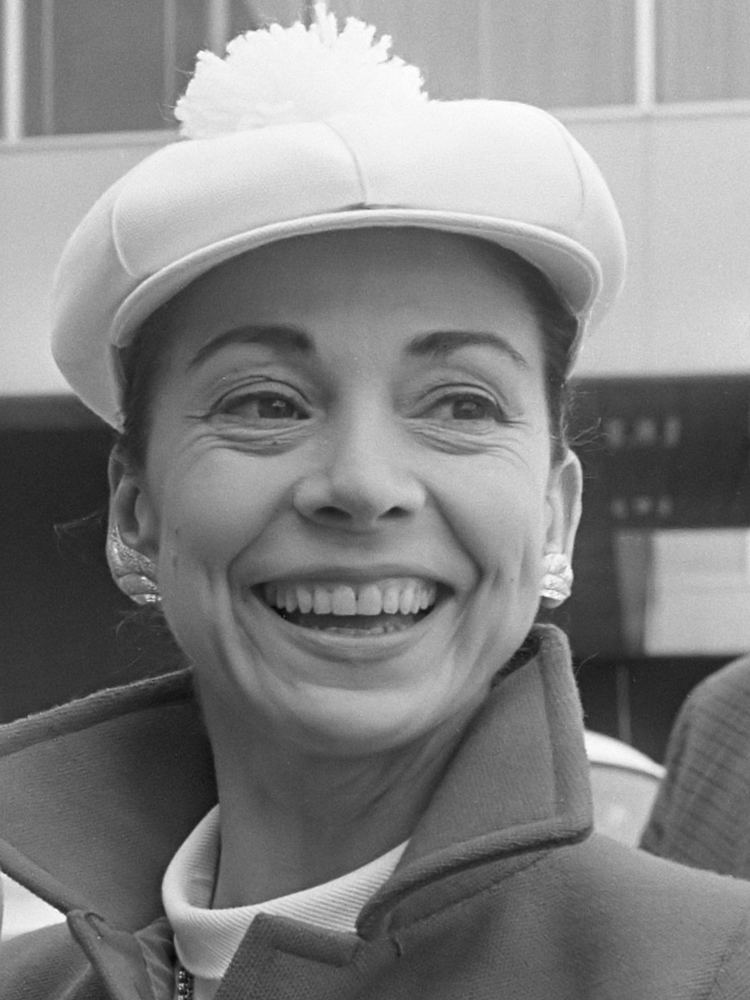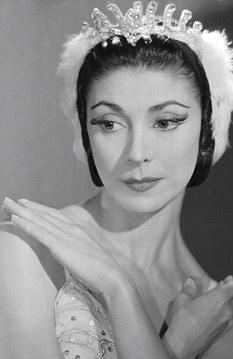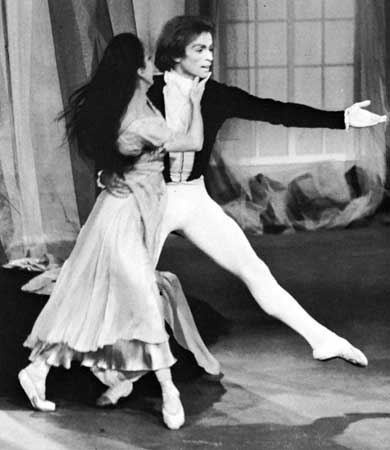Cause of death Cancer Employer Royal Ballet Known for Ballet | Nationality British Name Margot Fonteyn Occupation Ballerina Role Ballerina | |
 | ||
Full Name Margaret Evelyn Hookham Books Margot Fonteyn: Autobiography, The Magic of Dance Children Querube Brillembourg, Rosita Vallarino Movies Romeo and Juliet, The Perfect Partnership: Fonteyn a, Royal Ballet: An Evening, I am a Dancer, Rudolf Nureyev: A Documentary Similar People | ||
Margot fonteyn 1
Dame Margot Fonteyn de Arias, DBE (18 May 1919 – 21 February 1991), was an English ballerina. She spent her entire career as a dancer with the Royal Ballet, eventually being appointed Prima Ballerina Assoluta of the company by Queen Elizabeth II.
Contents
- Margot fonteyn 1
- Margot fonteyn interview 1984
- Early life
- Stage partners
- Relationships
- Legacy and honours
- Miscellany
- Film and television
- References

Margot fonteyn interview 1984
Early life

Fonteyn was born Margaret Evelyn Hookham on 18 May 1919 in Reigate, Surrey. Her father was a British engineer; among his family were people in literature and music. Her mother was half Irish and half Brazilian, the daughter of Brazilian industrialist Antonio Fontes. Very early in her career Margaret took the name by which she was known all her life, "Margot Fonteyn", with surname derived from "Fontes", also adopted by her brother—Portuguese "fonte" is "fountain" in modern English, "fonteyn" in Middle English. Her later formal married name was "Margot Fonteyn de Arias", in the Spanish-language tradition.

At four years of age her mother signed her and her elder brother up for ballet classes. At age eight, Margot travelled to China with her mother and father, who had taken employment with a tobacco company there; her brother Felix remained at his school. For six years Margot lived in TianJin, then in Shanghai, where she studied ballet with Russian émigré teacher George Goncharov. Her mother brought her back to London when she was 14, to pursue a ballet career. Continuing to work in Shanghai, her father was interned during World War II by the invading Japanese.

In 1933 Fonteyn joined the Vic-Wells Ballet School, the predecessor of today's Royal Ballet School, training under the direction of Ninette de Valois and such teachers as Olga Preobrajenska and Mathilde Kschessinska [Krzesinska]. After starting with the Vic-Wells Ballet, she rose quickly through the ranks of the company. By 1939 Fonteyn had performed principal roles in Giselle, Swan Lake and The Sleeping Beauty and was appointed Prima Ballerina. She was most noted in the ballets of Frederick Ashton, including Ondine, Daphnis and Chloe, and Sylvia. She was especially renowned for her portrayal of Aurora in Tchaikovsky's The Sleeping Beauty (televised versions of Sleeping Beauty and Ashton's version of Cinderella are available on DVD). Fonteyn also worked with choreographer Roland Petit and, later in life, Martha Graham. When the Royal Ballet toured the United States in 1949, Fonteyn instantly became a celebrity for her performances.
Stage partners

In the 1940s she and Robert Helpmann formed a very successful dance partnership, and they toured together for several years. In the 1950s she danced regularly with Michael Somes (they had first danced together in 1938 in Constant Lambert's Horoscope). In 1955, the year in which Fonteyn married a Panamanian diplomat, they danced together in the first colour telecast of a ballet, NBC's production of The Sleeping Beauty. In 1958 they appeared together in the first British televised version of The Nutcracker. She named Helpmann the favourite partner of her entire career.

Fonteyn began her greatest artistic partnership at a time when many people, including the head of the Royal Ballet, Ninette de Valois, thought she was about to retire. In 1961 Rudolf Nureyev defected to the West, and on 21 February 1962 he and Fonteyn first performed together in Giselle. She was 42 and he was 24. Their performance was a great success; during the curtain calls Nureyev dropped to his knees and kissed Fonteyn's hand. They created an on-and-offstage partnership that lasted until her retirement—with no pension—in 1979 at age 61, and were lifelong friends. Fonteyn and Nureyev became known for inspiring repeated frenzied curtain calls and bouquet tosses. Sir Frederick Ashton choreographed Marguerite and Armand for them, which no other couple danced until the 21st century. They debuted Kenneth MacMillan's Romeo and Juliet, although MacMillan had conceived the ballet for Lynn Seymour and Christopher Gable. Fonteyn and Nureyev appeared together in the filmed versions of MacMillan's Romeo and Juliet, Swan Lake, Les Sylphides, and the Le Corsaire Pas de Deux.
Despite differences in background and temperament, and a 19-year gap in ages, Nureyev and Fonteyn became close lifelong friends and were famously loyal to each other. Fonteyn would not approve an unflattering photograph of Nureyev. He said about her:
"At the end of 'Lac des Cygnes' when she left the stage in her great white tutu I would have followed her to the end of the world."
The extent of their physical relationship remains unclear; Nureyev said that they had one, while Fonteyn denied it. Her biographer Meredith Daneman agreed with Nureyev. The duo remained close even after she retired to a Panama cattle farm with her husband. She talked with Nureyev by phone several times a week, although her farmhouse did not have a telephone. When she had to be treated for cancer, he paid many of her medical bills and visited her often, despite his busy schedule as a performer and choreographer. In a documentary about Fonteyn, Nureyev said that they danced with "one body, one soul" and that Margot was "all he had, only her". An observer said that "If most people are at level A, they were at level Z."
Relationships
During the late 1930s and early 1940s Fonteyn had a long relationship with composer Constant Lambert. Lambert expressed some aspects of this in his ballet Horoscope (1938).
In 1955 Fonteyn married Dr Roberto Arias, a Panamanian diplomat to London. Their marriage was initially rocky because of his infidelities. She was arrested in Panama when helping Arias to attempt a coup d'état against the government in 1959. Confidential British government files released in 2010 showed that Fonteyn knew of and had some involvement in the coup attempt. In 1964 a rival Panamanian politician shot Arias, leaving him a quadriplegic for the rest of his life.
After her retirement she spent all her time in Panama, and was close to her husband and his children from an earlier marriage. She had no pension, and had spent all her savings looking after her husband. Shortly before her husband's death, in 1989, Fonteyn was diagnosed with a cancer that proved fatal. She died on 21 February 1991 in a hospital in Panama City, Panama, aged 71.
Legacy and honours
Miscellany
Fonteyn wrote the introduction for Wushu! The Chinese Way to Family Health and Fitness. The book was translated for the Western market by Timothy Tung from a series of official handbooks published in China by The People's Sports Publishing House, Beijing.
The "Margot Fonteyn Academy of Ballet" in Peekskill, New York, is named in her honour.
Margot Fonteyn wore Freed of London Ballet Pointe shoes in size 4.[1][2]
During her younger years, Fonteyn resided at 44 Waldeck Road and 3 Elm Grove, both in Ealing, London. It was at Waldeck Road that Danemen writes "It was on the polished oak staircase of the house in Waldeck Road that Margot claims to have had an experience of flying".
As a dancer, Fonteyn made her last appearance in Nureyev's 1979 summer season, and in February 1986 (aged 66) she appeared on stage for the last time, as the Queen in The Sleeping Beauty.
Film and television
She danced in the BBC Eurovision production of Sleeping Beauty in the title role with Jelko Yuresha on December 20, 1959. Fonteyn and Nureyev starred together in a colour film of Swan Lake in 1967. Under the guidance of director Paul Czinner, they also filmed their famous version of Romeo and Juliet in 1966. Fonteyn in 1975 presented her own six-part BBC2 series entitled The Magic of Dance, exploring the history of dance through five centuries, but it seems to have been lost since. The series caused a stir because up to that time she had not been known for speaking on camera. Terry Wogan commented that if that was an amateur speaking then the professionals should take note.
She appeared with Michael Somes in a live US television colour production of Tchaikovsky's The Sleeping Beauty (1955), for the anthology series Producers' Showcase, on NBC. This production has been preserved on black-and-white kinescope, and released on DVD. Fonteyn starred with Somes in a 1958 British TV production of The Nutcracker. (This is not to be confused with the live US television production telecast by CBS on Playhouse 90.)
The BBC made a film about Fonteyn, broadcast on 30 November 2009, based on Daneman's biography and starring Anne-Marie Duff as the ballerina.
Tony Palmer made a documentary about Fonteyn, titled simply Margot (2005). It includes interviews with Nureyev, Sir Frederick Ashton, Roland Petit, Ninette de Valois, Robert Helpman, Lynn Seymour, Fonteyn's sister-in-law and other relatives, and various members of the Arias family.
In the 1998 film Hilary and Jackie about British cellist Jacqueline du Pre, Fonteyn is portrayed by Nyree Dawn Porter.
